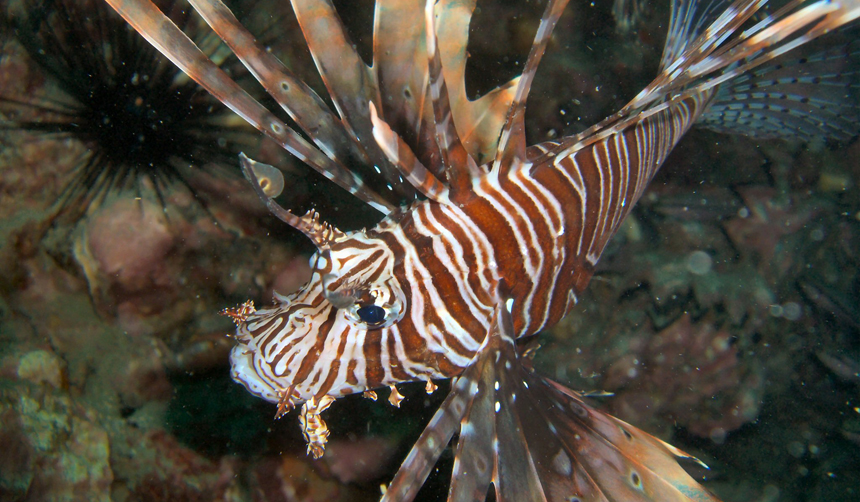Lionfish grow wary after culling

Invasive lionfish have become a problem in the Caribbean and along the U.S. East Coast. But efforts to control the fish may be making them more difficult to find, and kill, in the future.
Tim Sheerman-Chase/Flickr (CC BY 2.0)
- More than 2 years ago
The beauty of the lionfish, with its striking stripes and decorative fins, has made the members of the genus Pterois popular for aquariums. That popularity may have led to two species of the fish (P. volitans and P. miles) to make their way into the Atlantic, where they’ve become troublesome invasive species. How does a fish native to the South Pacific and Indian oceans get to the Atlantic? Scenarios include hobbyists dumping pet fish into the sea after they grew too big for their aquariums and pet lionfish being accidentally released in the destruction caused by Hurricane Andrew in 1992.
One of the main ways that people try to keep populations of invasive lionfish under control is to kill them through spearfishing. Some of those fish even get eaten. (They’re tasty, but people preparing lionfish need to be careful of their venomous spines.)
But the control efforts may not be perfect. In areas where lionfish are subject to spearfishing, the survivors quickly become wary during daylight hours, report Isabelle M. Côté of Simon Fraser University in Burnaby, Canada and colleagues April 4 in PLOS ONE.
The researchers compared the behavior of lionfish on patches of coral reef off Eleuthera Island in the Bahamas. On eight patches, divers removed as many lionfish as they could through spearfishing every three or six months for two years. On another eight patches, the lionfish had been left alone. Then the scientists compared the behavior of the fish.
Lionfish on the reefs that had been subject to culling tended to be less active and hide more compared with fish from the unculled patches. And any divers thinking they could sneak up on the fish would have a tough time on the culled reefs — those lionfish reacted sooner when a person was nearby. But this was only true during the day. At dawn, when humans with spears are unlikely to be in the water, the fish on the culled patches acted in a manner similar to their brethren on the coral reefs that had been left alone.
“These behavioral differences might result in lionfish being … more difficult to capture when encountered,” the researchers write. “Our results suggest that lionfish surviving a cull could become more difficult to remove in subsequent control efforts.”
The researchers aren’t sure whether learning or evolution is behind the behavioral change. It’s possible that the fish that survive the culling learn to avoid human divers. This would require that lionfish retain a memory for three or more weeks, but that’s within the ability of other fish species, so it’s potentially true for lionfish, too.
The alternative is that culling removes the most adventurous lionfish, leaving behind those that are naturally more cautious.
Either way, the result is a population of lionfish that is more watchful around humans and has a tendency to hide during the days. That could change when and/or how lionfish hunt, which could have unknown effects on other species, the scientists write. And it could make it more difficult for humans to keep lionfish populations under control, jeopardizing future conservation efforts.






